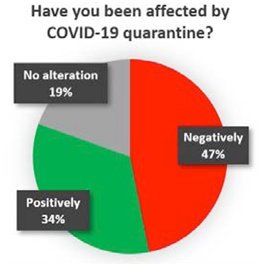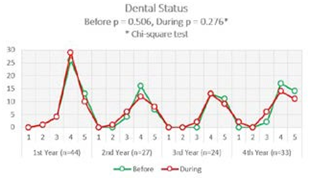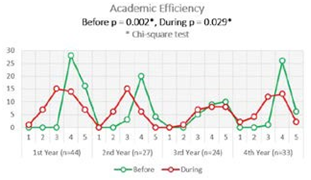INTRODUCTION
Dentistry is a medical profession that generates a high degree of physical and psychological stress amongst professionals and students of the career (1). Until now, the relationship between levels of stress, oral care and general health of dental students, have been conducted through an in-classroom learning environment (2). Also, it has been reported that high levels of stress induce a variety of reactions that lead to increased health risk (3). So, it is important to manage stress for the academic, psychological and physical wellbeing of health professionals and students (4).
Due to the COVID-19 pandemic declared by the World Health Organization (WHO) at the beginning of 2020, schools decided to indefinitely suspend in-person classes in order to decrease the risk of SARS-CoV2 transmission, forcing students to continue their academic work from home as of March 2020 (5). This period of quarantine and social isolation that has been imposed on students, has modified their environment and lifestyle (6). Therefore, it is important to understand how dental students perceive the way they have been affected by this unexpected situation.
Few scientific studies had been published worldwide describing the consequences of quarantine due to COVID-19 on physical and emotional health in dental students. Thus, the aim of this study was to analyze the self-perceived general health, oral care, stress, academic environment and harmful habits of Mexican dental students during the COVID-19 quarantine period.
MATERIALS AND METHODS
This descriptive observational study was approved by the Research Committee of the School of Dentistry at De La Salle Bajío University. There were recruited all the students who were currently enrolled in each semester of the School of Dentistry. A self-perception survey was sent to a total of 400 students, and those who accepted to participate completed a digital informed consent. Those students who responded completely to the survey were further divided into four groups, according to their scholar year (1st, 2nd, 3rd and 4th).
INCLUSION CRITERIA
The inclusion criteria were students of over 18 years of age of both sexes, who had voluntarily agreed to participate in the study and answered the surveys in its entirety. If participants requested their withdrawal from the study, their survey would be eliminated.
SELF-PERCEPTION QUESTIONNAIRE
A survey was created in which students were asked about their gender, age, school year, current location at the time of filing, with whom they were undergoing quarantine and their general affectedness perception. The survey was written and applied in Spanish.
41 items divided into 5 sections were included: General Health (based on SF-8TM Health Survey) (7), Oral Health (based on Oral Health Questionnaire for Adults) (8), Stress, Academic Environment and Habits (the questions of the three later categories were developed by our research team).
For each question, each student was asked to rate their perception prior to, and during the contingency, which allowed a comparison to be made between both times for each inquiry.
Example:
In general, how do you rate your health during this COVID-19 contingency:
In general, how do you rate your health before the COVID-19 contingency:
1=Very negative
2=Negative
3=Neutral
4=Positive
5=Very positive
The survey was created through Google Forms. Even though there was not performed a pre-test of the questionnaire with students, it was reviewed by the researchers and the Dean of the School of Dentistry, who decided it was adequate for the application.
The survey was sent to the students by way of Microsoft Teams in May 2020 (Week 10 of the quarantine). A reminder was sent to students who had not responded to the first request 7 and 15 days afterwards and the survey was concluded in June 2020 (Week No.12 of the quarantine).
STATISTICAL ANALYSES
The answers were collected into Microsoft Excel and descriptive statistics were performed, reporting mean, standard deviation and range for quantitative variables, as well as frequency and percentage for qualitative variables. The Kolmogorov- Smirnov test was used to determine the distribution of the variables, in addition to the Chi-square tests for the comparison between them. A value of p<0.05 was considered significant. The statistical analyses were performed using SPSS v. 20.
RESULTS
The survey was sent to a population of 400 dental students, composed by 274 females (68.5%) and 126 males (31.5%). The received responses were 128, with an acceptance rate of 32%.
In Table 1, the total number of participants (128) is observed, of which 110 (85.9%) corresponded to the female gender and only 18 (14.1%) to the male. All survey respondents were included in this study.
Table 1 Gender distribution by Scholar Year among the groups.
| - | Female | - | Male | - |
|---|---|---|---|---|
| Scholar Year | F | (%) | F | (%) |
| 1st Year (n=44) | 37 | (84.1) | 7 | (15.9) |
| 2nd Year (n=27) | 24 | (88.9) | 3 | (11.1) |
| 3rd Year (n=24) | 20 | (83.3) | 4 | (16.7) |
| 4th Year (n=33) | 29 | (87.9) | 4 | (12.1) |
| Total (n=128) | 110 | (85.9) | 18 | (14.1) |
F: Frequency.
Table 2 shows the distribution of ages by school year, with mean, standard deviation and range. The mean age of the population was 21.81±4.37, with a range of 18 to 48 years of age.
Table 2 Age distribution by Scholar Year.
| Scholar Year (n) | X ± SD (range)* |
|---|---|
| 1st Year (44) | 19.98 ± 2.13 (18-30) |
| 2nd Year (27) | 21.63 ± 2.94 (19-30) |
| 3rd Year (24) | 23.39 ± 5.43 (20-36) |
| 4th Year (33) | 24.51 ± 6.54 (21-48) |
| Total (128) | 21.81 ± 4.37 (18-48) |
X: mean; SD: Standard Deviation; n=128.
It was observed that only 5% of the students spent the quarantine period independently, while all the others did so accompanied by their family.
Regarding the self-perceived impact quarantine had on students, Figure 1 illustrates that 47% of students reported having been negatively affected, contrary to 34% of the sample, who reported a favorable change. Finally, 19% of the students did not perceive any alteration in their perceptions during the quarantine.
GENERAL HEALTH
Table 3 describes the distribution of students’ self-perceptions before and during quarantine. The categories were: General health, physical energy, social activities, emotional problems and daily performance. A statistically significant difference was observed between the student groups for the variable “emotional problems” during quarantine.
Table 3 Comparison Before Quarantine vs. During Quarantine self-perceptions among Scholar Years.
| - | p* Before Quarantine | p* During Quarantine |
|---|---|---|
| Self-perceived Health | - | - |
| General Health | 0.289 | 0.552 |
| Physical Energy | 0.058 | 0.432 |
| Social Activities | 0.952 | 0.075 |
| Emotional Problems | 0.497 | 0.048* |
| Daily Performance | 0.103 | 0.073 |
| Self-perceived Oral Health | - | - |
| Oral Health | 0.506 | 0.276 |
| Self-perceived Oral Care | - | - |
| Brushing Habits | 0.723 | 0.355 |
| Use of Floss | 0.505 | 0.498 |
| Use of Mouthwash | 0.280 | 0.155 |
| Self-perceived Stress | - | - |
| Stress | 0.788 | 0.131 |
| Self-perceived Academic Environment | - | - |
| Performance | 0.334 | 0.073 |
| Work-load | 0.173 | 0.0001* |
| Efficiency | 0.002* | 0.029* |
| Exams | 0.082 | 0.163 |
| Learning | 0.094 | 0.105 |
| Self-perceived Habits | - | - |
| Smoking | 0.903 | 0.604 |
| Alcohol | 0.958 | 0.897 |
| Sleep | 0.463 | 0.060 |
| Exercise | 0.021* | 0.123 |
| Electronic Devices | 0.934 | 0.413 |
* Chi-square test p<0.05.
Referring to the self-perceived state of “general health”, the 1st and 2nd year students had a change from positive to neutral, but there were no significant differences between the student groups for both times (p>0.05).
Regarding “physical energy” perceived by students in the time during the pandemic, the 1st and 2nd year groups showed a negative change, while there was no great variation amongst 3rd and 4th year students. There was no significant difference between the groups during quarantine. (p>0.05).
In “social activities” during the pandemic there were no significant differences between the student groups for both times (p>0.05).
When self-perceptions of “emotional problems” were reported, 1st-year students were the most affected during quarantine (p<0.05). In general, all groups showed a tendency towards negativity during the contingency, represented in Figure 2. There was no statistical significance when the emotional health of the students prior to quarantine was compared (p>0.05).
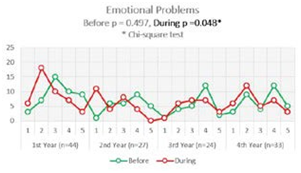
Figure 2 Emotional problems amongst dental students by scholar year. Note that 1st year students were the most affected during quarantine. Answers: 1= Very negative, 2=Negative, 3= Neutral, 4=Positive, 5=Very positive.
For “daily performance”, a greater impact was observed for the 1st and 2nd year groups during the contingency, although this data was not statistically significant (p>0.05).
ORAL HEALTH
Table 3 and Figure 3 show that students did not report any change about their oral health before and during the contingency, without statistical significance between the academic years (p>0.05).
Although the students reported an improvement in their frequency of tooth brushing, no item showed statistical significance (p>0.05).
STRESS
In regard to stress, 1st-year students showed the most drastic shift toward negativity, while no major changes were observed amongst 3rd and 4th year groups. The comparison between the academic years for both times did not obtain statistical significance, as observed in Table 3 (p>0.05).
ACADEMIC ENVIRONMENT
In comparing before and during quarantine perceptions, statistically significant differences were found for the variables “work-load” and “academic efficiency” (p<0.05).
It is observed that 1st, 2nd and 4th year students showed changes towards a less favorable perception of their “academic performance” for both times, although without statistical significance between the student groups (p>0.05).
Regarding the “work-load”, Figure 4 shows evident changes amongst 1st and 2nd year students towards an unfavorable perception during the pandemic, with statistical significance (p<0.05). On the other hand, between 3rd and 4th year students there were less noticeable differences, both favorable in 3rd year and unfavorable for 4th year students. Before the pandemic, no group was more affected than the other (p>0.05).
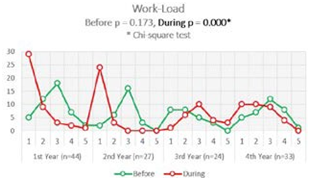
Figure 4 Self-perceived academic work-load amongst dental students by scholar year. Note that 1st and 2nd year students were the most affected during quarantine. Answers: 1=Very negative, 2= Negative, 3=Neutral, 4=Positive, 5=Very positive.
In the area of “academic efficiency”, a statistically significant difference was presented for both times (p<0.05), where 1st, 2nd and 4th year students presented better efficiency prior to quarantine, while 3rd year students did not undergo noticeable changes, as observed in Figure 5.
The perception that dental students had regarding “exams” seems to have worsened for the 1st and 2nd year groups, but did not demonstrate statistical significance (p>0.05).
For the “learning” variable, a negative change was perceived for the 1st, 2nd and 4th year groups. However, there was no statistical difference between them for both times (p>0.05).
HABITS
The only variable that presented a significant difference between the groups was “Exercise” before the pandemic (p<0.05), as seen in Table 3.
No significant difference was found for tobacco or alcohol consumption before and after the COVID-19 contingency in all school years (p>0.05).
In this study, 1st, 2nd and 4th year students reported having had a worse quality of sleep during quarantine, although it was not statistically significant (p>0.05).
Also, it was revealed that prior to the contingency, the group that exercised the most were 1st year students, with statistical significance (p<0.05), as illustrated in Figure 6. For the 3rd and 4th year students there was a slight improvement in “exercise” during quarantine, although without statistical significance (p>0.05).
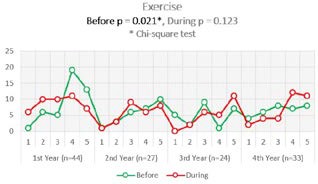
Figure 6 Exercise practice amongst dental students by scholar year. Note that 1st year students were the ones that exercised the most before quarantine. Answers: 1=Very negative, 2=Negative, 3=Neutral, 4=Positive, 5=Very positive.
In all the groups surveyed, an increase in the use of electronic devices was observed during the contingency, although a statistical significance was not obtained for both times (p>0.05).
DISCUSSION
The objective of the present study was to compare the self-perception of health, oral hygiene, stress, academic performance and harmful habits of dental students before and during the health contingency due to COVID-19, and thus identify the representative changes they experienced.
It is of our knowledge that this is the first study in Mexico to analyze the changes dental students have undergone due to the COVID-19 disease, declared a pandemic by the WHO in March 2020(5). This event modified the personal and academic way of life for such students (6).
When describing our population, it can be seen that the majority of individuals who answered the survey were female (85.9%). This may be due to the fact that in Mexico (9) and other countries (10), interest by part of women to study Dentistry has increased in recent years. In addition, it has been reported that women are more accepting to participate in voluntary academic surveys (11).
Fortunately, 95% of the surveyed students experienced the contingency period in company of their relatives. During this time, it must be acknowledged that each student experienced a different reality depending on the city where they resided, given differences in restrictions on the population and the frequency of infections by COVID-19.
It is surprising that a considerable percentage of students (34%) reported that quarantine had a positive effect on their lives. We assume this improvement stemmed fromindividuals finding a balance between their personal and academic activities during this time of uncertainty. This positive impact could be due to living with their family members, carrying out enjoyable activities, and resuming contact with other people through digital means despite social distancing.
GENERAL HEALTH
In this section, the results that presented statistical significance (p<0.05) belonged to the variable “emotional problems.”
When talking about physical energy, it is possible that transition into virtual classes created a sedentary lifestyle, which students were not used to. Studies have shown the inverse relationship that exists between sedentary lifestyle and the physical energy that one perceives (12).
Social distancing, in addition to making recreational activities difficult, also influenced the manifestation of emotional problems, which were more evident in the 1st year group, demonstrating statistical significance when compared to the other groups (p<0.05). These students perceived their new university experience interrupted by social distancing orders, as they had to return home and limit their socialization with classmates to virtual media. Studies have demonstrated benefits that face-to-face interactions have over virtual (13).
ORAL HEALTH
An interesting finding was that the self-perception of students regarding their oral health status did not change amongst school groups. However, a general improvement in tooth brushing practices was detected for all years. No item in this section presented statistical significance.
STRESS
Despite the sum of stressors, such as adaptation to a new academic style, a greater theoretical load and communication difficulties to continue with their classes and tasks, there were no statistically significant differences between the student groups regarding this category.
ACADEMIC ENVIRONMENT
Academic performance during quarantine for the 1st, 2nd and 4th year students changed from a positive to neutral perception, although it was not statistically significant. Studies have shown that virtual education can be beneficial as an accessory method of teaching dentistry (14). It is unclear how this approach, utilized as a principal method affects dental students in their learning.
During the quarantine period, 1st and 2nd year students, who spent approximately 6 to 7 hours per day in theoretical classes, suffered a negative change in work-load (p<0.05). Contrary to this, for students in their final years, the theoretical load was reduced given that their clinical and laboratory activities could not be met during the contingency, resulting in vacant hours (15).
In the results of this study, a significant change in the self-perception of academic efficiency for the 1st, 2nd and 4th year groups was seen during quarantine (p<0.05). This could be caused by the interruption of preclinical practices, laboratory work and clinical care of patients, which are representative activities of dental school training.
HABITS
Regarding tobacco and alcohol consumption (16), it could be said that the quarantine was beneficial for students’ health (17), as a decline in their consumption was slightly observed. In addition, the quality of sleep (18) was negatively affected amongst 1st and 2nd year students, possibly due to a higher load of virtual tasks.
In regard to physical exercise, it is notable that 1st year students exercised more frequently than other groups before quarantine, probably due to their free time during the semester (p<0.05). Meanwhile, during the quarantine, the advanced year students had greater opportunities to exercise as a result of their newly acquired free time.
As a last variable, the use of electronic devices increased for all groups during quarantine, without preference for any particular group.
RELATED FINDINGS
Other authors also had studied the impact of the COVID-19 pandemic among dental students. Chi et al. (19) found that 69% of survey dental students in Washington (USA) reported a negative impact in their mental health, with manifestations such as anxiety, depression or burnout, which could lead students to drop out of school.
On the other hand, Yildirim et al. (20) found higher anxiety levels in female and clinical dental students. Also, these results were similar to those of an international study conducted by Klassen et al. (21). They found that those dental students who worried about their academic progress, also referred higher anxiety levels. The authors proposed that faculty support may diminish negative effects in dental students.
Moreover, Gaş et al. (22) reported a worse quality of sleep in dental students during COVID- 19 pandemic, accompanied by symptoms of anxiety, depression and temporomandibular joint disorders.
LIMITATIONS
One of the limitations of this study was the acceptance of dental students to participate. At last, the response rate was 32%. Nevertheless, the completed surveys are considered to be a representative sample of the analyzed population. Another limitation was the scarce participation of male students, which could be explained by the high percentage of women that studies Dentistry (68.5% of the analyzed population).
CONCLUSION
To conclude, a trend towards unfavorable perception in relation to general health, academic environment and harmful habits was observed among dental students during social isolation derived from the pandemic.
When comparing oral health before and during social distancing, a general trend was observed in all groups towards the maintenance of good hygiene habits.
The findings of this study indicate that 1st-year students presented a greater impact on all the variables of interest, especially on self-perception of emotional problems, work-load, academic efficiency and physical exercise. It is considered that the youngest students are those who require greater attention and assistance to avoid negative affections during the contingency period of COVID-19.














